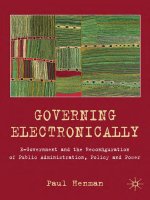Handbook of Public Management Practice and Reform docx
Bạn đang xem bản rút gọn của tài liệu. Xem và tải ngay bản đầy đủ của tài liệu tại đây (2.39 MB, 807 trang )
ISBN: 0-8247-0429-0
This book is printed on acid-free paper.
Headquarters
Marcel Dekker, Inc.
270 Madison Avenue, New York, NY 10016
tel: 212-696-9000; fax: 212-685-4540
Eastern Hemisphere Distribution
Marcel Dekker AG
Hutgasse 4, Postfach 812, CH-4001 Basel, Switzerland
tel: 41-61-261-8482; fax: 41-61-261-8896
World Wide Web
The publisher offers discounts on this book when ordered in bulk quantities. For more
information, write to Special Sales/Professional Marketing at the headquarters address
above.
Copyright © 2001 by Marcel Dekker, Inc. All Rights Reserved.
Neither this book nor any part may be reproduced or transmitted in any form or by any
means, electronic or mechanical, including photocopying, microfilming, and recording, or
by any information storage and retrieval system, without permission in writing from the
publisher.
Current printing (last digit):
10987654321
PRINTED IN THE UNITED STATES OF AMERICA
To my father,
Jiunn-Jin Liou
and
in memory of my mother,
Der-Jy Wann
Preface
Public management reform is one of the most popular topics in the field of public
administration. Both academics and practitioners have been actively involved in
studying it. Researchers have published numerous articles and books examining
the background, motives, concepts, strategies, implementation, effectiveness, and
lessons of many reform policies and programs. Practitioners are interested in
learning new managerial ideas and reform policies to advance their knowledge
and skills so that they can improve their management of public organizations and
provide better service to their communities.
Over the past several decades, many reform ideas, policies, and programs
have been recommended and implemented in major areas of public administra-
tion. In budgeting and financial management, for example, recent reform efforts
introduced new policies to improve performance, increase productivity, promote
accountability, cut expenditures, and reduce the size of government. Similar
reform efforts have been recommended in the human resource management area.
Latest reform efforts emphasize the importance of accountability, flexibility,
decentralization, privatization, and deregulation in civil service systems at all lev-
els of government.
My interest in public management reform has to do with three aspects of my
academic research at both micro- and macro-levels. First, I was interested in the
topic of public budgeting reform and focused not only on the concept and tech-
v
niques of various budgeting systems but also on the politics and challenges
involved in the reform process. Then, I addressed this topic from the organiza-
tional development and policy implementation approaches and concentrated on
such issues as organizational environment, leadership, culture, communication,
and strategies that are important to the success of any reform policies and organi-
zational changes. Finally, I emphasized the importance of public management
reform in my recent studies of economic development in many developing and
economic-transition countries. The issues of interest are broader and include the
role of government in economic development, decentralization and deregulation,
institutional arrangement and support, and corruption and bureaucratic dysfunc-
tions in the transition process, as well as cooperation among public, private, and
nonprofit organizations.
To edit a big book on public management reform and practice is not an easy
task. It has taken more than four years to develop and prepare this volume. I first
proposed to develop a book related to the ideas, changes, and challenges in recent
public management reforms. Based on comments and recommendations from Dr.
Jack Rabin and Mr. Marcel Dekker, I expanded the scope by incorporating many
changes and challenges in the environment of public administration, the practices
and functions of public management, the experience and issues of recent reform
efforts, and the new ideas and directions in public administration, as well as the
development and contribution of public administration education, research, and
professional associations.
The process of editing this book has been a pleasant experience for me. I
have had opportunities to work with many outstanding scholars who were inter-
ested in this project. I thank Dr. Jack Rabin, the editor of the Public Administra-
tion and Public Policy series, for his acceptance of my original proposal and sug-
gestions on the content of the book. All the contributors have been wonderful as
they worked hard to finish their chapters according to my general guidelines, and
they were patient with the review and revision process. I am also grateful for the
assistance of my outstanding staff, John Mullen and Michelle Morales at the Uni-
versity of Central Florida, during the research and communication stage of this
project. I especially appreciate the professional dedication of staff members at
Marcel Dekker, Inc. Their dedication and skills were important to the final pro-
duction of this book. Finally, strong support from my family has been critical in
finishing this book. My wife, Susan, has spent a lot of time taking care of our three
children (Alan, Anna, and Alex) and other family business, which allowed me to
concentrate on my research. I owe all to their love and encouragement.
Kuotsai Tom Liou
vi Preface
Contents
Preface v
Contributors xi
Introduction xv
Part I. Environmental Changes and Public Management
1 Politics, Paradox, and the “Ecology” of Public
Administration: Challenges, Choices, and Opportunities for
a New Century
Robert F. Durant 1
2 Global Economic Changes and Public Management
Susan J. Tolchin and Kenneth E. Cox 35
3 Society’s Values and Public Management
Mongomery Van Wart 57
4 Technology and Public Administration
Daniel J. Jorgensen and W. Earle Klay 75
vii
Part II. Changes in Budgeting and Financial Management
5 Reforming American Government Accounting in the
20th Century
James L. Chan 97
6 Unfinished Agenda in Public Financial Management
A. Premchand 123
7 Changes and Administrative Reforms in Local Government
Budgeting
Jerry A. Gianakis 139
8 Changes and Reforms in Tax and Public Revenue Systems
John R. Bartle 159
Part III. Changes in Human Resource Management
9 Human Resource Management Change in State and Local
Government
N. Joseph Cayer and Sandra J. Parkes 183
10 Changing Roles and Duties Within Government’s Human
Resources Profession: Contemporary Models and Challenges
Steven W. Hays 205
11 Changes and Reforms in Public Labor–Management
Relations
Richard C. Kearney 225
12 Developmental Performance Appraisal: Feedback, Interview,
and Disciplinary Techniques
Dennis M. Daley 243
Part IV. Issues in Organizational and General Management
13 Using Strategic Planning to Manage Strategically in the
Public Sector
Frances Stokes Berry 261
14 Productivity Improvement and Public Management
Marc Holzer and Kathe Callahan 291
15 Measuring Government Performance
Kathryn E. Newcomer 321
viii Contents
16 Ethics and Public Management
Donald C. Menzel 349
Part V. Policy Issues and Public Management
17 Win-Win Public Management
Stuart S. Nagel 365
18 Privatization Policy and Public Management
Van R. Johnston and Paul Seidenstat 389
19 Economic Development Policy and Public Management
Kuotsai Tom Liou 405
20 Deregulation Policy and Public Management
John P. Tuman, John Hindera, and Danielle Roth-Johnson 431
Part VI. Reform Experience and Issues
21 Looking Back, Looking Forward: What Did Reinvention Do?
Patricia W. Ingraham and Donald P. Moynihan 447
22 Reforming Public Administration: Including Citizens
Cheryl Simrell King and Camilla Stivers 473
23 Downsizing in the Public Sector: Implications for
Public Administration
Mary Ann Feldheim 493
24 Four Models of Public Sector Change
A. Carol Rusaw 513
25 The New Public Management and Reform
Jamil E. Jreisat 539
Part VII. New Ideas and Markets in Public Management
26 Service Contracting and Alternative Service Delivery:
Theory and Practice
Richard C. Feiock 561
27 The Impact of the New Public Management on
Nonprofit Organizations
Joan E. Pynes and Lisa M. Arndt 573
Contents ix
28 Public Policy and the Continuous Improvement Paradigm:
A Plea for the Total Learning Community
Henry B. Thomas 589
29 Rumbling Doubt About Managerial Effectiveness and a Turn
Toward Discourse
Hugh T. Miller, Mohamad Alkadry, and John Donohue 607
30 NGOs and Grass-Roots Organizations in Developing Countries
Keith M. Henderson 619
Part VIII. Changes and Issues in Professional Education and Associations
31 Changes and Reforms in Public Administration Education
Thomas Vocino and Linda C. Wilson 637
32 Issues in Doctoral Education
Jay D. White 663
33 The American Society for Public Administration and the
Field of Public Administration
Mary R. Hamilton 675
34 A Recent History of NASPAA
Michael A. Brintnall 713
35 Recognizing Excellence in Public Administration and Affairs
Education and Practice: Pi Alpha Alpha
Charles W. Washington 725
Index 755
x Contents
Contributors
Mohamad Alkadry Division of Public Administration, West Virginia Univer-
sity, Morgantown, West Virginia
Lisa M. Arndt Public Administration Program, University of South Florida,
Tampa, Florida
John R. Bartle Department of Public Administration, University of Nebraska at
Omaha, Omaha, Nebraska
Frances Stokes Berry Askew School of Public Administration and Policy,
Florida State University, Tallahassee, Florida
Michael A. Brintnall National Association of Schools of Public Affairs and
Administration, Washington, D.C.
Kathe Callahan Graduate Department of Public Administration, Rutgers Uni-
versity, Newark, New Jersey
N. Joseph Cayer School of Public Affairs, Arizona State University, Tempe,
Arizona
xi
James L. Chan Department of Accounting, University of Illinois at Chicago,
Chicago, Illinois
Kenneth E. Cox Department of Public and International Affairs, George Mason
University, Fairfax, Virginia
Dennis M. Daley Department of Political Science and Public Administration,
North Carolina State University, Raleigh, North Carolina
John Donohue School of Public Administration, Florida Atlantic University,
Fort Lauderdale, Florida
Robert F. Durant School of Public Affairs, University of Baltimore, Baltimore,
Maryland
Richard C. Feiock Askew School of Public Administration and Policy, Florida
State University, Tallahassee, Florida
Mary Ann Feldheim Department of Public Administration, University of Cen-
tral Florida, Cocoa, Florida
Jerry A. Gianakis Department of Public Administration, University of Central
Florida, Orlando, Florida
Mary R. Hamilton American Society for Public Administration, Washington,
D.C.
Steven W. Hays Department of Government and International Studies, Univer-
sity of South Carolina, Columbia, South Carolina
Keith M. Henderson Department of Political Science, State University
College–Buffalo, Buffalo, New York
John Hindera Department of Political Science, Texas Tech University, Lub-
bock, Texas
Marc Holzer Graduate Department of Public Administration, Rutgers Univer-
sity, Newark, New Jersey
Patricia W. Ingraham Department of Public Administration, Syracuse Univer-
sity, Syracuse, New York
xii Contributors
Van R. Johnston Department of Management, University of Denver, Denver,
Colorado
Daniel J. Jorgensen Department of Social Sciences, Texas A & M University
Corpus Christi, Corpus Christi, Texas
Jamil E. Jreisat Public Administration Program, University of South Florida,
Tampa, Florida
Richard C. Kearney Department of Political Science, East Carolina University,
Greenville, North Carolina
Cheryl Simrell King Graduate Program in Public Administration, The Ever-
green State College, Olympia, Washington
W. Earl Klay Askew School of Public Administration and Policy, Florida State
University, Tallahassee, Florida
Kuotsai Tom Liou Department of Public Administration, University of Central
Florida, Orlando, Florida
Donald C. Menzel Division of Public Administration, Northern Illinois Uni-
versity, DeKalb, Illinois
Hugh T. Miller School of Public Administration, Florida Atlantic University,
Fort Lauderdale, Florida
Donald P. Moynihan Department of Public Administration, Syracuse Univer-
sity, Syracuse, New York
Stuart S. Nagel Political Science Department, University of Illinois, Urbana,
Illinois
Kathryn E. Newcomer Department of Public Administration, George Wash-
ington University, Washington, D.C.
Sandra J. Parkes Department of Political Science, University of Utah, Salt
Lake City, Utah
A. Premchand National Institute of Public Finance, New Delhi, India
Contributors xiii
Joan E. Pynes Public Administration Program, University of South Florida,
Tampa, Florida
Danielle Roth-Johnson Department of Political Science, Texas Tech Univer-
sity, Lubbock, Texas
A. Carol Rusaw Department of Communications, University of Southwestern
Louisiana, Lafayette, Louisiana
Paul Seidenstat Department of Economics, Temple University, Philadelphia,
Pennsylvania
Camilla Stivers Maxine Goodman Levin College of Urban Affairs, Cleveland
State University, Cleveland, Ohio
Henry B. Thomas Department of Political Science and Public Administration,
University of North Florida, Jacksonville, Florida
John P. Tuman Department of Political Science, Texas Tech University, Lub-
bock, Texas
Susan J. Tolchin Department of Public and International Affairs, George
Mason University, Fairfax, Virginia
Montgomery Van Wart Department of Political Science, Texas Tech Univer-
sity, Lubbock, Texas
Thomas Vocino Department of Political Science and Public Administration,
Auburn University at Montgomery, Montgomery, Alabama
Charles W. Washington School of Public Administration, Florida Atlantic Uni-
versity, Fort Lauderdale, Florida
Jay D. White College of Public Affairs and Community Service, University of
Nebraska at Omaha, Omaha, Nebraska
Linda C. Wilson Department of Political Science and Public Administration,
Auburn University at Montgomery, Montgomery, Alabama
xiv Contributors
Introduction
Public management reform has been one of the major policy and research issues
in the field of public administration for many decades. The interest in reforming
the management of public organizations results from the emergence of new ideas
and issues related to many changes and challenges in the political, social, eco-
nomic, and technical environments of the public sector. After being examined in
the political process, these new reform ideas and issues will be implemented as
official public policies and programs that gradually become major components of
public management practices. Researchers of public administration and policy
have been actively involved in providing new concepts and ideas of public man-
agement to policymakers, debating about the values of reform proposals during
the policy formulation stage, examining the effectiveness of official policies dur-
ing the implementation and evaluation stages, and discussing the final experience
and lessons (good and bad) of the reform policies. The field of public administra-
tion in many ways represents a continuous cycle and process of ideas, reforms,
xv
I recognize that there may be conceptual problems associated with many terms used in this book. For
example, public management reform has also been related to other similar terms, such as administra-
tive reform, administrative improvement and modernization, and administrative change and innova-
tion. I use the term public management reform because it represents the latest effort in improving the
management of government business. The contributors to this book may select other terms as result of
different backgrounds and interests in their research.
practives, feedback, and new ideas that are influenced by changes and challenges
in the environment.
For policymakers, the interest in reforming government bureaucracies is not
a new policy issue in the United States. In the 20th century, we have experienced
a series of new ideas and policies attempting to improve the federal government
(Moe, 1992). These reform efforts include many official commissions or commi-
tees on reforms, including 1) The Keep Commission (1905–1909, under President
T. Roosevelt), 2) The President’s Commission on Economy and Efficiency
(1910–1913, under President Taft), 3) The Joint Committee on Reorganization
(1921–1924, under President Harding), 4) The President’s Committee on Admin-
istrative Management (1936–1937, under President F. D. Roosevelt), 5) The First
Hoover Commission (1947–1949, under President Truman), 6) The Second
Hoover Commission (1953–1955, under President Eisenhower), 7) The Study
Commissions on Executive Reorganization (1953–1968, under Presidents Eisen-
hower, Kennedy, and Johnson), 8) The Ash Council (1969–1971), under President
Nixon), 9) The Carter Reorganization Effort (1977–1979), 10) The Grace Com-
mission (1982–1984, under President Reagan), and 11) Gore’s National Perfor-
mance Review (since 1993, under President Clinton).
The motives behind these reform efforts have to do with policy changes that
are related to specific political needs and vision, emerging social values and atti-
tudes, and new managerial principles and strategies. Based on different consider-
ations, these reform commissions and committees had recommended many policy
and managerial changes in the size of federal government and on the power of the
Executive Office of the President and its control over administration agencies,
regarding the management of human resources, budgeting and finance, organiza-
tional structures, and agency operation and procedure.
For example, the recent National Performance Review (NPR) represents
one of the latest efforts to improve the management of U.S. government. Affected
by Osborne and Gaebler’s Reinventing Government work (1992), the NPR works
to identify many root problems of the federal government and attempts to change
governmental agencies to entrepreneurial organizations (Gore, 1993). The prob-
lems of federal government include out-of-date bureaucratic rules and procedures,
hierarchical organization designs and structures, and political interest and influ-
ence of distrust in public employees. The NPR’s suggestions for creating entre-
preneurial organizations are based on such principles as: 1) cutting red tape and
asking employees to be accountable for achieving results, 2) putting customers
first and insisting on customer satisfaction, 3) empowering employees (through
labor–management cooperation, training, and assistance) to get results, and 4) cut-
ting back to basics by re-examining programs and procedures and re-engineering
how employees do their work to make government work better and cost less.
These reform suggestions have been emphasized and implemented in many func-
xvi Introduction
tional areas of public management, such as human resource management, budget-
ing, and financial management, at all levels of government.
Similar reform ideas and policies for improving the management of govern-
ment have been emphasized in many developed and developing countries. One of
the recent reforms that received worldwide attention is the New Zealand model,
which is based on theoretical concepts of public choice theory, principal-agent
theory, transaction-cost theory, and the new public management ideas of privati-
zation, decentralization, deregulations, taxation reduction, performance-oriented
management, and the streamlining of public business. The policy components of
the New Zealand model consist of reform of government commercial enterprises
(to corporatize these public enterprises), reform of the core departments (to
emphasize the contract relationship between the government and bureaucrats by
addressing accountability, performance, delegation, incentives and punishments,
value of money, and customer service), and economic policy reforms (to address
the government’s overall economic policy in the Reserve Bank Act and the Fiscal
Responsibility Act) (Bale and Dale, 1998; Boston et al., 1991)
These reform ideas and policies have quickly attracted attention in develop-
ing countries. For developing countries, the interests in public management
reform are based not only on the desire to introduce modern management systems
(ideas, techniques, or processes) to make the administration more efficient and
effective in the delivery of services to the public, but also on the need for an admin-
istrative apparatus adequate for performing the important roles of government in
managing the economy (United Nations, 1983; Liou, 1998). To promote economic
growth and social development, many international development and aid organi-
zations have stressed the importance of public management reform in their finan-
cial assistance plans. For example, the International Monetary Fund, the United
Nations development organizations, and the World Bank have always demanded
some type of public management reform in developing countries, including the
privatization of many government organizations and activities, the reorganization
and adjustment of government structures, and the overhaul of banking and finan-
cial systems. Government reform is one of the key factors and challenges for these
countries to promote economic development (Liou, 2000).
Recognizing the importance of reform policies, public administration
researchers have been actively involved in the study of reform experience and les-
sons. For example, researchers generally agree that reform policies are popular, but
the records of the reform policies have been disappointing (Caiden, 1991). There
are many environmental, organizational, and personality obstacles to the reform
policies (Caiden, 1999, 1991, 1969; Rosenbloom, 1998). The environmental obsta-
cles refer to many factors related to geography, history, technology, polity, culture,
and society. The organizational obstacles consist of common managerial problems
such as resources, planning, schedules, strategies, implementation, monitoring,
Introduction xvii
and evaluation. The personality obstacles have to do with problems of the reformer,
including the reform’s ideologies and responses to the difficulties and failures, and
the limitations of the reform’s ideas, knowledge, data base, analyses, and recom-
mendations. To overcome these problems, many researchers (Caiden, 1991; Peters
and Savoe, 1994; Rosenbloom, 1998) have emphasized a diagnostic reform model,
which promotes the importance of a pragmatic approach, specific strategies and
treatments for different situations, and a gradual and long-term commitment to the
reform (Liou, 1999).
The purpose of this book is to offer the latest and most comprehensive infor-
mation on changes and issues related to public management reform, practice, edu-
cation, and professional development. The book emphasizes the link between pub-
lic management practice and reform ideas and experience. It also identifies several
new challenges and potential markets in public management. The book especially
recognizes the important contribution of public administration education to pro-
fessional development and examines many issues related to changes in public man-
agement education, research, and professional associations.
The organization of this book consists of eight parts and 35 chapters. Part I
(Chapters 1 to 4) provides background information about environmental changes
and their impact on public management. Part II (Chapters 5 to 8) focuses on
changes in the area of public budgeting and financial management. Part III (Chap-
ters 9 to 12) covers major changes in public human resource management. Part IV
(Chapters 13 to 16) identifies important issues and changes that related to organi-
zational and general public management. Part V (Chapters 17 to 20) includes sev-
eral selected policy issues and their impact on public management. Part VI (Chap-
ters 21 to 25) examines past reform experiences and critical issues in public
management reform. Part VII (Chapters 26 to 30) addresses new ideas, challenges,
and emerging markets in public management. Part VIII (Chapters 31 to 35) reviews
challenges to public administration education and changes in professional associ-
ations.
Finally, in each chapter, all the authors have tried to explain the importance
of their topic issue, provide a background review of theoretic or policy develop-
ment of the topic, examine major concepts and critical issues that are related to the
topic, and discuss the impact, implication, and future development of the topic
issue.
REFERENCES
Bale, M. and T. Dale (1998). Public Sector Reform in New Zealand and Its Relevance to
Developing Countries, The World Bank Research Observer 13(1):103–121.
Boston, J., J. Martin, J. Pallor, and P. Walsh (eds.) (1991). Reshaping the State: New
Zealand’s Bureaucratic Revolution, Auckland: Oxford University Press.
Caiden, G. E. (1969). Administrative Reform, Chicago: Aldine Publishing Company.
xviii Introduction
Caiden, G. E. (1991). Administrative Reform Comes of Age, Berlin: Walter De Gruyter.
Caiden, G. E. (1999). “Administrative Reform—Proceed with Caution,” International
Journal of Public Administration 22(6):815–832.
Gore, A. (1993). Creating a Government that Works Better and Costs Less: Report of the
National Performance Review, Washington, D.C.: U.S. Government Printing Office.
Liou, K. T. (1998). Managing Economic Reforms in Post-Mao China, Westport, CT:
Praeger.
Liou, K. T. (1999). “Strategies and Lessons of China’s Post-Mao Economic Development,”
Policy Studies Review 16(1):183–208.
Liou, K. T. (ed.) (2000). Administrative Reform and National Economic Development,
Aldershot, England: Ashgate Publishing Ltd.
Moe, R. C. Reorganizing the Executive Branch in the Twentieth Century: Landmark Com-
mission, Report 92-293 GOV, Washington, D.C.: Congressional Research Service,
Library of Congress, March 19, 1992
Osborne, D. and T. Gaebler (1992). Reinventing Government, Reading, MA: Addison-Wes-
ley.
Peters, B. G. and D. J. Savoie. (1994). “Civil Service Reform: Misdiagnosing the Patient,”
Public Administration Review 54(5):99–106.
Rosenbloom, D. H. (1998). “Observations on American Administrative Reform,” Interna-
tional Journal of Public Administration 21(10):1393–1421.
United Nations. (1983). Enhancing Capabilities for Administrative Reform in Developing
Countries, New York: The Author.
Introduction xix
1
Politics, Paradox, and the “Ecology” of Public
Administration: Challenges, Choices, and
Opportunities for a New Century
Robert F. Durant
School of Public Affairs, University of
Baltimore, Baltimore, Maryland
In his classic Reflections on Public Administration (1947), John Gaus wrote per-
ceptively of the “ecology” of public administration and its relationship to the rise
of the administrative state (Waldo, 1948). Specifically, he recounted how crises
and changes in people, place, physical technology, social technology, and philos-
ophy during the first half of the 20th century led citizens repeatedly to look to gov-
ernment for relief from the negative externalities accompanying them. Politicians,
in turn, created or expanded the powers of public agencies to “help craft new insti-
tutional bases . . . [to] . . . enable the individual to find development . . . satisfac-
tion . . . and some sense of purpose.”
Implicit in Gaus’s work was how the “administrative orthodoxy” of the Pro-
gressive reform movement informed society’s response to these transformations
(Knott and Miller, 1987). A central linchpin of this orthodoxy was the unique abil-
ity of public agencies to pursue the public interest if organized on Weberian prin-
ciples, if run like businesses by strong executives, if staffed by nonpartisan pro-
fessional experts, and if focused on procedural fairness. Central as well for
1
2 Durant
realizing the public interest was a vibrant economic regulatory regime animated
by two overriding purposes: to protect the public from market failures in various
industries (mostly from monopolies) and to promote the growth and prosperity of
those same industries (e.g., the financial securities, transportation, and energy sec-
tors of the economy). As time passed a final, albeit implicit, linchpin of the admin-
istrative orthodoxy became the superiority of national solutions to society’s ills.
The federal government was the only institution with sufficient authority, will, and
capacity to offset concentrations of economic power; to ameliorate the problems
that accompanied otherwise positive societal changes; and to build a floor of secu-
rity below which no citizen should fall.
Gaus’s depiction of an expanding administrative state as the answer to
modernity’s problems held true for nearly a quarter-century after Reflections. For
example, as racism, chronic unemployment, and inadequate housing plagued
minorities, and as health care maintenance problems soared among the impover-
ished elderly, the Great Society was launched in the 1960s. Indeed, so ingrained
and apparently irreversible was this predisposition that the early 1970s saw Pres-
ident Nixon expand the administrative state even further by adding what scholars
called the “new social regulation” (e.g., environmental protection, employee
health and safety, and consumer protection) to the earlier economic mix (Lilly and
Miller, 1977). With the new social regulation, of course, came agencies to imple-
ment these rights-based statutes (e.g., the Environmental Protection Agency, the
Occupational Safety and Health Administration, the Consumer Product Safety
Commission, and the Equal Employment Opportunity Commission).
Since the mid-1970s the United States has continued to undergo social, eco-
nomic, and technological transformations not unlike those described by Gaus, and
at a decidedly more rapid pace. Known widely as the “Third Wave” shift from an
industrial to an information-based economy (Toffler, 1980), these transformations
caused unprecedented gains alongside protean pains of social, economic, and
political adjustment. Curiously, however, the Third Wave has evoked a decidedly
different response to the challenges, choices, and opportunities it affords. Philo-
sophically, the administrative state is now portrayed as the problem to which mar-
kets are the solution, rather than vice versa.
Regnant as a new millennium begins is a “downsizing, defunding, and
devolution” (D
3
) agenda that turns the Progressive reform vision on its head
(Durant, 1998). Decidedly “neoliberal” in philosophy (Peters, 1996), the D
3
agenda values
“busting” bureaucracies, not building them
devolving policy and program responsibilities to states, localities, nonprofit
agencies, and private contractors, not centralizing them in Washington or
within organizations
devolving administrative authority to, and within, agencies, not concentrat-
ing it in central administrative units or hierarchies
The “Ecology” of Public Administration 3
deregulating business and financial capital to let markets flourish in a global
economy, not regulating them
exposing public agencies to market and quasi-market competition, not insu-
lating them
focusing on results, not on procedures
politicizing whatever public bureaucracy remains, not depoliticizing it
What caused this epochal change in zeitgeist from the one that Gaus
depicted for the first half of the 20th century? The reasons are multiple, complex,
and entangled. Some see in it the result of overreaching by the administrative state.
Supporters of the Great Society portray it as an effort to complete Roosevelt’s
unfinished New Deal agenda of expanding “political rights” to include the protec-
tion of equal opportunity. Critics say that much of it violated citizens’sense of fair-
ness by creating “entitlements” without obligations and promoting equality of out-
come rather than opportunity (Milkis, 1993; Etzioni, 1994; Galston, 1999).
Similarly, others argue that the new social regulation went too far beyond
“old-style” economic regulation, thus planting the seeds of its own political
destruction (Wilson, 1990; Whitman, 1999). The latter promoted as well as regu-
lated industry, whereas the former eschewed promoting industry interests. More-
over, whereas old-style regulation proceeded on an industry-by-industry basis,
social regulation cut across all industries and imposed high compliance costs upon
them. Thus, as Arab oil embargoes, economic slowdowns, and international com-
petition strained corporate profits, a formidable cross-industry coalition existed to
demonize all regulation.
Still others elaborate and extend the first two arguments. They either view
the administrative state itself as an aberration of the values that Lipset (1996) asso-
ciates with American exceptionalism (Galston, 1999) or claim that proponents of
the D
3
agenda were more adroit in “selling” their agenda politically by grounding
it in these values (Durant, 1998). Most notable among these are liberty, egalitari-
anism (predicated on equality of opportunity), individualism, populism, laissez-
faire market orientation, optimism, pragmatism, and affinity toward local rather
than national political institutions (Lipset, 1996). As such, the expansion of the
administrative state from the New Deal through the Cold War reflected a prag-
matic response to difficult circumstances. However, it was premised on values so
incongruent with American exceptionalism that it could not last once circum-
stances changed (Galston, 1999).
Plausible as well are explanations that the administrative state is ineffective
and inefficient, although this argument is more of a caricature than an apt gener-
alization. Serious scholars, political appointees from both parties, and impartial
observers have marshaled a great deal of empirical evidence to the contrary (e.g.,
Goodsell, 1994; Rainey, 1996; Holzer and Callahan, 1998). Moreover, citizens
typically rank three programs administered directly by the federal government as
4 Durant
exemplary (Social Security, Medicare, and the national parks). Still, even a cur-
sory reading of administrative law texts, of the bureaucratic politics and public
management literatures, or of policy implementation studies affords enough
scholarly support to make the case against bureaucracy compelling in many
instances. Whether the fault lies in a “bureaucracy problem” or a “governance
problem” is debatable (Meier, 1997).
At the same time the realpolitik of administrative reform in the United States
is also partially responsible for the ascendancy of the neoliberal agenda. As
Rosenbloom and Ross (1994) argue, the dominance of administrative theories has
historically had less to do with their validity than with the power of a dominant
political coalition to offer and sustain them. In this instance, and premised on very
different values, New Democrats trying to protect a positive state agenda and
vying with Republicans for the Perot vote after the 1992 presidential election com-
bined with minimalist state proponents to enact and preserve the D
3
agenda. Each
could claim that the federal government was shrinking, “doing more with less,”
and attacking federal budget deficits.
Still, others in the realpolitik school note that cross-party alliances on U.S.
trade policy have coalesced around the neoliberal agenda because of the benefits
they and their corporate constituents derive from the rise of global capitalism, the
information and telecommunications revolution, and vast improvements in global
transportation systems. These trends are used to buttress arguments that the
administrative state is an obstacle to prosperity, must be redesigned to make it
more “market friendly,” and can be effectively reconfigured by following the D
3
agenda (Korten, 1996). The global economy, this coalition argues, requires nations
to prune the size of their public sector welfare and regulatory regimes. Doing so
will stimulate their economies, attract and maintain international business and
investor capital, and position them better to compete globally on the basis of com-
parative advantage. To be sure, some see no mischief afoot in the ascendancy of
this cross-party alliance (e.g., Friedman, 1999; Whitman, 1999). Yet others see the
coalition driven by the increasing reliance of the Republican and Democratic par-
ties on campaign contributions from transnational corporations and the securities
industry (e.g., Greider, 1997).
Finally, others maintain that the ascendancy of the D
3
agenda (and most espe-
cially its “reinventing government” components) depends less on the merits of
neoliberal arguments than on the multimillion-dollar consulting industry that mar-
kets its precepts globally (Saint-Martin, 1998). Students of economic reforms in
former Communist and totalitarian nations would add another, more nefarious rea-
son: the illicit financial gains that accrue to some political leaders and their friends
when they privatize state-owned enterprises (Chari, 1998; Rosenberg, 1999). Not
all from the political economy perspective agree, however. Some looking at priva-
tization and contracting in France, Great Britain, and the United States see more
noble, yet nevertheless controversial, reasons for the privatizing and contracting
The “Ecology” of Public Administration 5
components of the D
3
agenda. Specifically, they are efforts to reduce budget deficits
both to stimulate the economy and to reinvigorate industries especially hard hit by
recession or global competition (Zahariadis, 1995; Whitman, 1999).
Whatever its fundamental causes, the D
3
agenda is said by some to produce
a “hollow state” in its wake (Milward and Provan, 1993; Milward, 1994). Left are
downsized federal agencies trying to catalyze and monitor nonhierarchical imple-
mentation structures of cross-sectoral (public, private, and nonprofit) partnerships
with a scale, level of complexity, and opaqueness that are unprecedented in the
United States. Moreover, what remains of the administrative state too often lacks
the capacity to do effectively what reformers say is necessary (e.g., set priorities,
focus on results, and monitor partners for accountability). This is the case because
of inadequate financial management, capital investment, human resource, and
information management systems (The Government Performance Project, 1999).
This would not be as worrisome if the condition of these systems were better in the
states, but wide and disturbing disparities in capabilities exist among these as well
(ibid.).
If Paul Light’s (1999) estimates are taken as a point of departure, a vast
chasm now exists between the political rhetoric and reality of downsizing the
administrative state in Washington to 1.8 million employees. Counting the num-
ber of jobs involving contractors, grants-in-aid to state and local governments, and
nonprofit agencies now delivering devolved federal responsibilities, a “shadow
state” of nearly 17 million employees exists and is growing. The Pentagon, for
example, expects to outsource another 230,000 jobs to the private sector by 2005,
and the Federal Activities Inventory Reform Act (FAIR) of 1998 requires federal
agencies to submit to the Office of Management and Budget (OMB) a list of all
positions that can be outsourced to private firms in the future. Thus, the United
States is not so much shrinking the administrative state as it is altering its metes
and bounds. Created in the process is a “neoadministrative state” in which combi-
nations (or “partnerships”) of public, private, and nonprofit actors are given the
authority to act on behalf of the state.
How likely are these trends to continue in the United States? Although no
one can say for sure, examining the potential durability of the political economy
that presently supports the rise of the neoadministrative state offers important
clues. Arguably, no better approach exists for doing this than applying the “ecol-
ogy” of public administration framework Gaus used to chronicle the rise of the
administrative state in America. Taking this approach, the remainder of this chap-
ter (a) identifies the major trends that have led to the rise of the neoadministrative
state, (b) assesses how likely they are to endure, and (c) enumerates some of the
major challenges, choices, and opportunities that they create for public adminis-
tration practice, research, and theory. From this analysis, I conclude that political
debates framed in terms of markets versus bureaucracy misstate the quintessential
issues posed by the emergence of the neoadministrative state in the United States.









